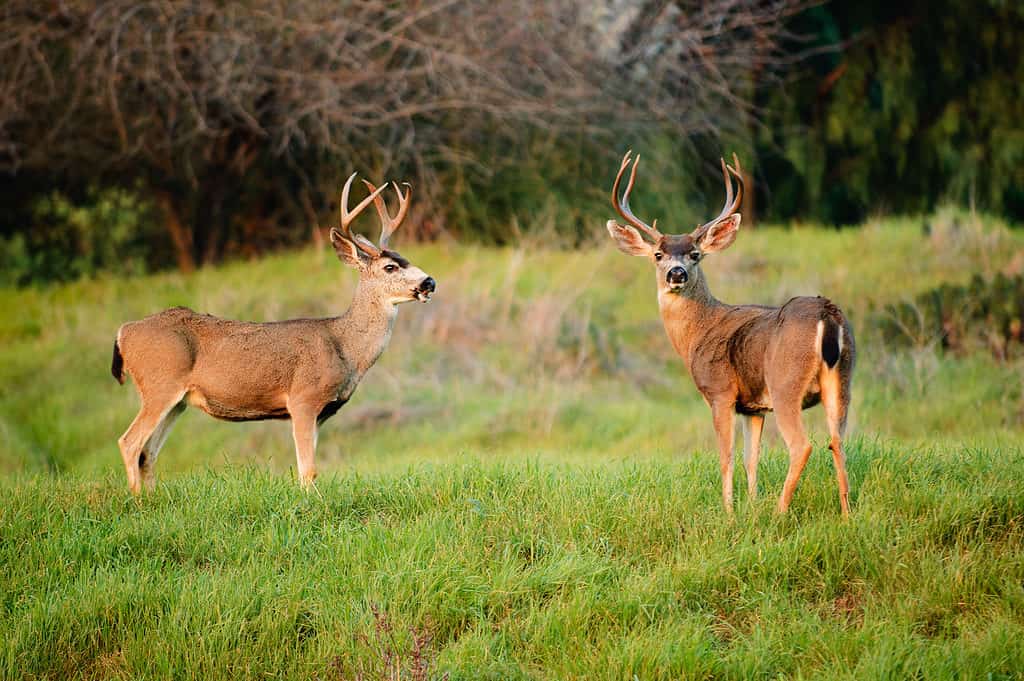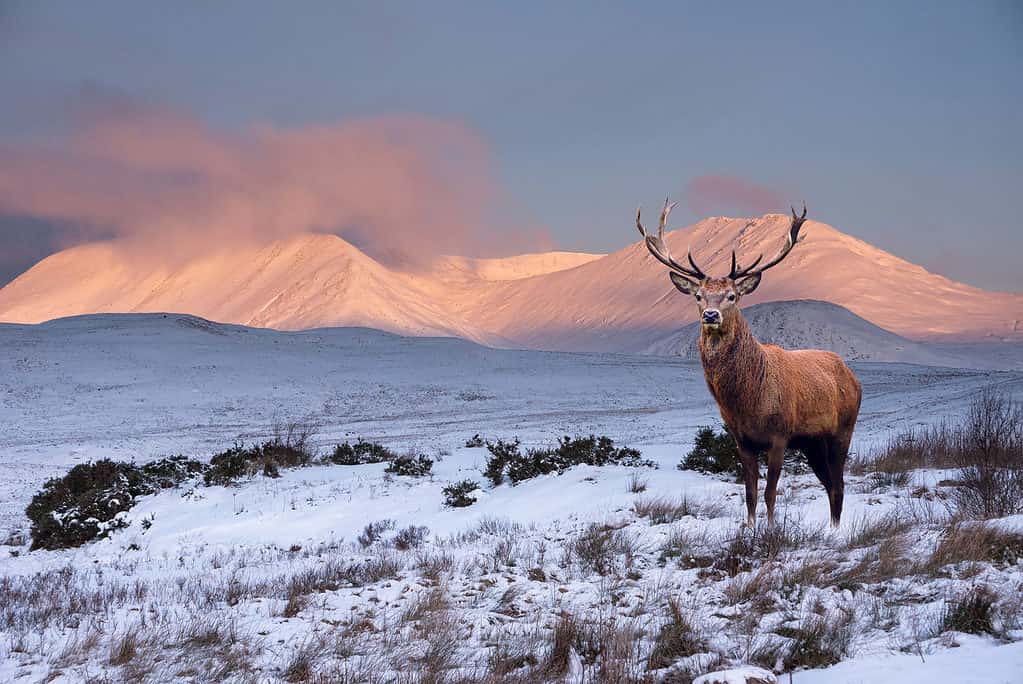Deer are adorable animals you can find throughout North and South America. They adapt to diverse environments and climates differently. Each type of deer is unique. There are 43 species of deer. Many of them live in regions where winters are cold and brutal.
Interestingly, not all deer migrate in the winter, like other animals. Those that don’t rely on special features and abilities to stay warm and survive. In this blog, we are going to dive into where deer go in the winter and how they survive the cold.
How Do Deer Survive The Winter?

Each deer species survives winter differently. For example, some white-tailed deer migrate during winter, but they don’t always move far.
©Jeffrey B. Banke/Shutterstock.com
Each deer species survives winter differently. For example, some white-tailed deer migrate during winter, but they don’t always move far. In fact, they look for “deer yards” to rest and eat. These “deer yards” are outdoor spaces that can cover dozens of acres. The yards offer protection from the snow and can fit multiple deer.
Deer also trade their cool summer coats for thicker winter fur in fall. The fur is thicker, longer, and darker. Not only is it warmer, but the fur also repels water. Since the fur is dark, it absorbs sunlight and traps heat which protects them from the cold and snow. In the fall, a deer’s body retains more fat in layers which acts as a food and energy source when deer hunker down in intense weather.
What is the Average Lifespan of a Deer?
Most male deer will live up to about the average age of six years old. Some may live shorter, some longer. Females typically live a few years longer than bucks. In fact, the record white-tailed deer was a doe that was discovered in Georgia. It is believed to have lived a staggering 22 years.
Human hunting is by far the greatest reason for mortality rates among deer and deer species. Deer won’t mate for life and will live and travel separately except when it’s time to reproduce. Bucks will then travel alongside other males for most of the year and then rejoin females during the mating season.
While humans are generally the main cause of mortality in deer species, another challenge for this animal is diseases. Deers are prom to CWD which is a wasting disease and an epizootic hemorrhagic disease or otherwise known as EHD.
Common Types of Deer
Before we dive more into how these wonderful animals survive winter, we should learn about the common types. Listed below are five common deer and some fun facts about each.
White-Tailed Deer
White-tailed deer are very common in North America except for the Southwest. These beautiful deer have light tan or brown coats in the summer and dark grayish-brown coats in the winter. They also have unique white markings underneath their tail and on their throat, eyes, and stomach. White-tailed deer fawns are red with white markings, which helps them stay safe. They are also herbivores and interestingly have four chambers within one stomach.

White-tailed deer have light tan or brown coats in the summer and dark grayish-brown coats in the winter.
©iStock.com/Matt Dirksen
Red Deer
Red deer are large animals. Adult males weigh up to 440 pounds. Red deer are common throughout Europe, Iran, and Western Asia. They are also ruminants, hooved grazing animals with four stomach chambers. During fall, they grow thick coats of reddish-brown fur, which helps them survive cold winters. When they shed during spring and summer, they run themselves against rough trees to get rid of excess fur.

During the fall, red deer grow thick coats of reddish-brown fur which helps them survive cold winters.
©iStock.com/Matt_Gibson
Siberian Musk Deer (Vampire Deer)
Siberian musk deer are small and more commonly known as vampire deer. They are distributed throughout Inner Mongolia, Manchuria, the Korean peninsula, and Siberia. These deer live in mountain forests and use their small bodies to expertly hide from predators. As their name suggests, they have very long tusks instead of antlers. Sadly, they are poached and their population is declining. Siberian musk deer travel at night and only migrate short distances.

Siberian musk deer are small and commonly known as vampire deer because they have long tusks instead of antlers.
©Suvorov_Alex/Shutterstock.com
Reindeer
Reindeer aren’t just flying animals in Christmas stories. They actually exist and belong to the genus Rangifer. Interestingly, wild reindeer are called caribou, while domesticated ones are reindeer. They thrive in cold and mountainous regions in Siberia, North America, the Artic, and Europe. These deer travel in large herds, the largest containing between 400,000 and 1,000,000 reindeer in Siberia. Unlike other deer species, female reindeer also grow antlers.

Reindeer have evolved to thrive in arctic tundra regions such as Siberia.
©Vladimir Melnikov/Shutterstock.com
South Andean Deer
Technically, South Andean deer are endangered, so they aren’t common, but they are an interesting deer species. They are native to the Andes. These small deer have short and stocky bodies built for rough and rocky terrain. Their coats are greyish brown with white undersides and necks. Male South Andean deer have a black ‘face mask’ marking and shed their antlers every year. In Argentina, their biggest predator is the cougar.

South Andean deer are small with short and stocky bodies built for rough and rocky terrain.
©iStock.com/JeremyRichards
What Do Deer Eat in the Winter?
Deer slightly change their diets during winter. Less food sources are available as they die out due to the cold. Deers living in cold and snowy regions consume more berries and nuts. They find whatever is available including twigs, grasses, berries, and bulbs. During winter, it’s tempting to want to feed wild deer, but experts recommend against it. Feeding them human food or food outside of their diet can give them diarrhea, which leads to dehydration. Severe dehydration is deadly.

Deer adjust their diets during winter since fewer food sources are available.
©iStock.com/steverts
What Do You Do If You See a Deer in Winter?
Deer are more afraid of you than you are afraid of them. If you spot them during winter, you have nothing to worry about. They are not aggressive toward humans and are more likely to run away and camouflage in the woods. If the deer appears injured or needs help, contact your local Licensed Wildlife Rehabilitator. If you get involved, you can accidentally make the situation worse without the proper training.
How Do Deer Sleep?
Because they are prey to several types of predators in the wild, deer must be very careful about how they sleep and when they choose to do so. They are obviously vulnerable when they do get sleep, and sleep is required much like most other animals on the planet; however, they are not nearly as hard sleepers as humans or predators that can afford the luxury of deep, relaxing rest.
Interestingly, deer are always on their guard even while resting. Their ears continue to stay upright throughout sleep, and they can respond to noises or smells very quickly. It is actually extremely rare for hunters and biologists to come across a deer that is snoozing.
Deer go through short cycles of sleep that last for roughly thirty minutes. They will alternate between dozing for less than a minute and then short times of alertness. They will typically rest during the day and in an area that provides good cover to hide them.
Adapting to this sleep style is one of the many ways deer have been able to survive in the wild!
The photo featured at the top of this post is © iStock.com/Lynn_Bystrom
Sources
- University of New Hampshire, Available here: https://extension.unh.edu/resource/more-harm-good-why-you-shouldnt-feed-deer
Thank you for reading! Have some feedback for us? Contact the AZ Animals editorial team.






